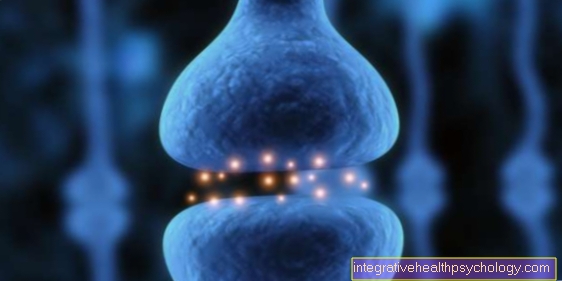Implants in the MRI
definition
In recent years, MRI has become increasingly important in non-invasive diagnostics. With the help of a strong magnetic field and electromagnetic waves, different tissues in the body can be represented. However, these can also act on implants located in the body.
Implants are artificial materials that are permanently or long-term inserted into the body (e.g. prostheses, cochlear implants, artificial heart valves, etc.).
Some metal-containing implants pose risks for the patient and can influence the image quality. Therefore, in the last few years there has been an increasing number of implants with which MRT imaging is possible without risk to the patient.

How does an implant affect image quality?
The Effects on the image quality of the MRI are of the materials and the Size of the implants dependent. Especially at ferrous (ferromagnetic) materials show up significant artifacts. Locally missing image information ("deletions"), distortions in the image and spatial incorrect coding (structure is shown in the wrong place) are possible. In contrast, artifacts occur less frequently with implants containing titanium.
The cause of the disturbance in image quality is a local one Disturbance of the magnetic field in the body. In the vicinity of the magnetic materials, the magnetic field is disturbed in a way that the detectors of the MRT cannot register. Often there are light lines in the marginal area of the disturbances that can be misinterpreted by the doctor.
In order to minimize the impact of implants on image quality, in recent years special recording techniques designed to improve imaging. With the help of special metal sequences, artifacts and distortions can be minimized. For this it is important that the patient informs the doctor about implants or other possible metallic structures in the body so that this particular MRI image can be performed. As a rule, MRI devices with a magnetic field strength of 1.5 Tesla are preferred.
You might also be interested in: Procedure of an MRI
Risks of MRI with implants in place
Risks to the patient with implants can be from both strong magnetic field as well as the emitted radio waves (high frequency) go out. The radio waves emitted by the MRT machine induce and transmit an electric current in metals. It comes to one strong warmingwhat 1st degree burns (superficial) to 3rd degree (deep) are possible. With the implants used today, however, this is extremely rare due to the avoidance of harmful materials.
In addition, the strong magnetic field can cause a Attraction and movement of magnetic metals (including iron) come. This attraction or movement depends on the position and stability of the materials:
- Large screws, such as those used on the spine, arms and legs, do not normally pose a risk.
- Small and loose materials (e.g. fresh stents) can be moved by the magnetic field and thus damage surrounding structures.
The assessment of possible risks lies solely with the doctor. With the exception of a few implants that are guaranteed by the manufacturer to be MRI compatible, the doctor must weigh the risks and benefits of imaging. In some cases, other imaging options can be used.
Various prostheses / implants
Knee prosthesis - is an MRI possible?
An MRI scan on a patient with a prosthetic knee is available possible. Most of the prostheses used today are MRI-compatible and pose no risk to the patient.
A limitation of the image quality is possible. This depends on the material and the shape of the prosthesis. With the ones commonly used nowadays Cobalt chrome or titanium prostheses artifacts are not very pronounced in the imaging.
Hip prosthesis - is an MRI possible?
An MRI scan on patients with hip prosthesis is also possible. Most of the prostheses used are comparable to knee prostheses MRI compatible and therefore do not pose any risk to the patient. Only a reduction in image quality is possible.
These artifacts depend on the material and shape of the hip prosthesis. The prostheses used today, which are made of cobalt-chrome or titanium, among other things, show only a few artifacts in the imaging of the MRI.
Read more about the topic here: MRI of the hip
Breast implants - is an MRI possible?
Breast implants consist of an inner bag that is filled with silicone gel and a shell that is filled with water. Neither substance poses a risk for MRI imaging. Possible cracks in the implant can even be made visible with the help of an MRI, as silicone is clearly different from water in an MRI. In addition, the MRI is often intended to rule out possible recurrences of breast cancer.
Read more about the topic here: MRI for breast cancer
Problems can arise from so-called expanders, some of which contain a metallic port. Expanders are bags that can be filled with saline from the outside in order to expand the space in the breast area for the use of a prosthesis.
Cochlear implant - is an MRI possible?
Cochlear implants consist of three components:
- an external hearing aid with microphone that registers incoming sound waves and transmits them to a transmitter coil on the scalp
- a transmitter coil that transmits the sound waves to an implanted receiving coil
- a receiving coil that transmits the stimulus via a long multi-channel electrode into the inner ear and stimulates the auditory nerve there.
In particular, the transmission of information between the transmitter and the implanted receiving coil takes place with the help of magnets.
An MRI can cause a strong movement and a cancellation of the magnetic effect of the implanted receiver coil. For this reason, an MRI scan is required in patients with a cochlear implant not possible.
exception put new implants some of which contain easy-to-remove magnets or work completely without magnets.
The patient should inform the doctor about the structure of his cochlear implant in a conversation. Surgical removal of the implant may be necessary if MRI imaging is urgently needed.
Head implants
There are many different forms of implants in the head area: Implants in the area of the large vessels (e.g. Stents, clips), central implants of the brain stem and implants on the skull bone.
The vascular implants (stents, clips) used nowadays are usually MRI compatibleas they made of titanium getting produced. Only older implants can contain magnetic metals, which is why MRI imaging is not possible.
At Stents it must be taken into account that in the first 6 to 8 weeks MRI imaging should not be performed after stenting. This is because the stent needs about this time to grow together with the vessel wall.
Brain stem implants (central auditory implants, ABIs) are used to directly stimulate the auditory pathways in the area of the brain stem. This is a modified cochlear implant, whereby the auditory pathway in the inner ear is stimulated electrically instead of the inner ear. Imaging with the MRT is possible, however, strong artifacts and image disturbances occur in the vicinity of the implant. Therefore, MRI imaging does not make sense. Sometimes high-resolution computed tomography (CT) can be used.
Implants of the face or skull consist of smooth-walled silicone and pose with it no contraindication for an MRT. In addition, MRT imaging is also possible with dental implants, which are usually made of titanium, ceramic or gold.
Artificial heart valve
There are two different forms of artificial heart valves:
- heart valvesthat completely made of metals consist
- Bioprostheses that usually contain no or only very small traces of metals.
Studies have shown that artificial heart valves pose no risk to the patient when imaging with an MRI (1.5 Tesla). Only artifacts can occur, especially with metallic prostheses.





























